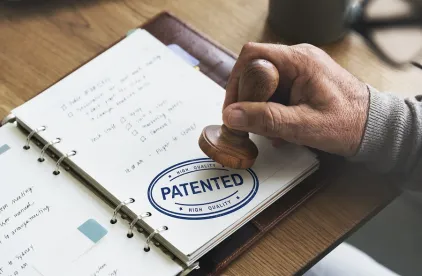A patent claiming methods to integratephysiological treatment data remotely using a computer was held invalid under 35 U.S.C. § 101. University of Florida Research Foundation, Inc. v. General Electric Company, et al. (Fed. Cir., Slip Op. 2018-1284, February 26, 2019). The Federal Circuit affirmed the district court’s invalidity decision on a motion to dismiss and provided a reasoned analysis of § 101 jurisprudence for computer-implemented methods. The decision provides useful guidance to innovators who seek to patent certain computer-implemented methods that integrate select genomic or clinical patient data into a larger data set for analysis or clinical guidance.
US Patent No. 7,062,251
US Patent No. 7,062,251 (the ‘251 Patent) titled “Managing Critical Care Physiologic Data Using Data Synthesis Technology” is assigned to appellant University of Florida Research Foundation Inc. (UFRF). In 2017, UFRF sued General Electric and other GE-related business (GE) for patent infringement in the U.S. District Court for the Northern District of Florida. GE moved to dismiss the suit on the ground that the ‘251 Patent claims are directed to ineligible subject matter under 35 U.S.C. § 101. The district court granted GE’s motion, and held that the claims were indeed directed to an abstract idea and do not recite an inventive concept. UFRF appealed.
Representative Claim 1 recites:
A method of integrating physiologic treatment data comprising the steps of:
receiving physiologic treatment data from at least two bedside machines;
converting said physiologic treatment data from a machine specific format into a machine independent format within a computing device remotely located from said bedside machines;
performing at least one programmatic action involving said machine-independent data; and
presenting results from said programmatic actions upon a bedside graphical user interface.
As explained in the patent’s specification, the invention addresses the inefficiencies in acquiring bedside patient information using pen and paper methodologies, such as flowsheets and patient charts. Slip Op. at 7, citing the ‘251 Patent at 1:21-23. While a manual pen and paper process inefficient, time-consuming, and expensive, it also can result in transcription errors resulting in improper treatment. Slip Op. at 7, citing ‘251 Patent at 1:37-31 and 2:3-5. The claimed invention’s proprietary methods use different data formats, protocols, and tailored applications uniquely written to integrate data from multiple bedside machines. Slip Op. at 7-8, citing the ‘251 Patent at 2:26-34. The ‘251 patented invention therefore replaces pen and paper methodologies with data synthesis technology in the form of “device drivers written for the various beside machines that allow the bedside devices to present data from the various bedside machines in a configurable fashion with a single interface.” Slip Op. at 8, citing ‘251 Patent at 3:3-15.
The Federal Circuit analyzed the claims under the Alice two-step framework, citing Alice Corp. Party Ltd. v. CLS Bank International, 573 U.S. 208, 217 (2014). Under Step 1, the claim is analyzed to determine if it is directed to a patent ineligible concept. In not, then the claim is patent eligible. If it is directed to a patent ineligible concept, then the analysis proceeds to Step 2 where the claim is analyzed to determine if it contains an inventive concept sufficient to transform the claimed abstract idea into a patent eligible application of that concept.
Merely An Abstract Idea – Step 1
The Federal Circuit determined that the claim was directed to an ineligible “abstract idea” of collecting, analyzing, manipulating, and displaying data because it merely sought to automate using a computer what had previously been performed using pen and paper, citing Intellectual Ventures I LLC v. Capital One Fin. Corp., 850 F.3d 1332, 1340 (Fed. Cir. 2017) and Elec. Power Grp., LLC v. Alstom S.A., 830 F.3d 1350, 1353-54 (Fed. Cir. 2016). The court emphasized that although “automation [that] can ‘result in life altering consequences … is laudable,” its use will not render the claim less abstract. Slip Op. at 8.
The court also noted that the specification and claims do not identify any specific improvements in the way computers operate. The ‘251 Patent taught the use of general purpose computers to carry out the claimed method. The court noted that the claimed element of “presenting results from said programmatic actions upon a bedside graphical user interface” also does not limit the presentation of the results from the programmatic actions using any specific graphical user interface. Slip Op. at 9, citing ‘251 Patent at 13:16-18.
The court also disagreed with patentee’s argument that the claim is eligible because the remote “converting” function of the computer (i.e., converting the physiological treatment data from a machine specific format using a driver for each different bedside machine) makes the claim similar to the claims found patent eligible in Visual Memory LLC v. NVIDIA Corp., 867 F.3d 1253 (Fed. Cir. 2017).
In Visual Memory, the court explained, the claims recited “‘an enhanced computer memory system’ that used ‘programmable operational characteristics configurable based on the type of processor’” to enabled interoperability with multiple different processors. Slip Op. at 9. This feature allowed the memory system to outperform prior art memory systems with a cache many times larger than the cumulative size of the subject cache. The Federal Circuit emphasized that the patent in Visual Memory not only claimed the improvement, it also explained how it worked.
In contrast, the court found that unlike Visual Memory, neither the ‘251 Patent specification nor claims provide any technical details for the technical components, and that no explanation of how the drivers do the conversion that the patentee points to are provided by the patent. “The mere function of converting is not a ‘specific improvement to the way computers operate.’” Slip Op. at 10, citing Enfish, LLC v. Microsoft Corp., 822 F.3d 1327, 1336 (Fed. Cir. 2016).
In sum, the Federal Circuit determined that the claimed method was directed to a patent ineligible abstract idea and thus proceeded to analyze the claim under Step 2 of the Alicetest.
No Inventive Concept
The claim failed here too. UFRF argued that the claim was more than well understood or conventional activities because the “converting” took place at a remote location, citing BASCOM Global Internet Services, Inc. v. AT&T Mobility LLC, 827 F.3d 1341 (Fed. Cir. 2016). In BASCOM, the Federal Circuit found “an inventive concept in ‘the installation of a filtering tool at a specific location, remote from the end-users, with customizable filtering features specific to each end user.’” Slip Op. at 10, citing BASCOM, 827 F.3d 1341, 1350 (Fed. Cir. 2016).
The court disagreed and explained that in BASCOM, the technical improvement over prior art ways of filtering content was explained. In contrast, the method of the ‘251 Patent is able to be practiced “on [a]ny kind of computer system or other apparatus adapted for carrying out the methods described herein.” Slip Op. 10-11, citing ’251 Patent at 13:27–33. The court determined that the claims did no “’more than simply instruct the practitioner to implement the abstract idea . . . on a generic computer.’” Slip Op. at 10 citing Alice, 573 U.S. at 225.
For these reasons, the Federal Circuit affirmed the district court’s holding that the ‘251 Patent was invalid under 35 U.S.C. § 101 for claiming an abstract idea.
Teaching Technical Details
Several aspects of the personalized delivery of health care rely on collecting, storing and analyzing data sets and mining that data for clinically relevant information, e.g., matching patients to clinical trials based on collected patient clinical data, collecting and analyzing genomic data to discover biomarkers that may identify the best treatment for a future patient, and collecting and analyzing clinical data from previous clinical drug trials that may target a similar biochemical pathway to guide a clinical trial for a new drug or indication. The rejected claim in UFRF may be similar to certain computer-implemented medical methods used in precision medicine in that the URFR claim describes collecting and analyzing clinically relevant information. Thus, the decision is a good tutorial for inventors seeking to patent computer-implemented methods such as these. They should take note that even though the ‘251 Patent claim was acknowledged by the court to present an advancement over prior methods, the lack of technical details as to how the data was analyzed by or with the computer ultimately doomed it to fail Step 2 of the Alice analysis.




 />i
/>i
